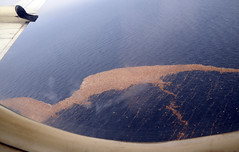NEWPORT, Ore. – A section from a huge dock that ripped loose from its moorings in the northern Japanese city of Misawa during the massive earthquake and tsunami in March of 2011 will become part of an exhibit at the Hatfield Marine Science Center, just a few miles from where it washed ashore in early June of this year.
The dock, which became an instant tourist attraction for several weeks, has since been dismantled. But a piece of the huge structure has been saved and will be on display at the HMSC by early next year.
The City of Newport is providing initial funding for the project and Mayor Mark McConnell hopes donations will fill the gaps. When finished, the dock section will be mounted outside of the HMSC Visitor Center, accompanied by educational signage as well as a memorial plaque. The exhibit is being developed by Oregon Sea Grant, which manages the Visitor Center, and will serve as the start of an eventual interpretive trail built along the tsunami evacuation route from the OSU center to higher ground.
“That would certainly be fitting,” said McConnell, who visited Sendai, Japan, last summer. “The devastation we saw in Japan was incredible. You realize when you see it first-hand that you can’t plan or build for an event of that magnitude, but you can prepare for it by educating yourself about the risks and creating strategies for safe evacuation.
“The exhibit will be a reminder that the tragedy in Japan could just as easily happen here,” he added.
Shawn Rowe, an OSU free-choice learning specialist based at the Hatfield Marine Science Center, said the focus of the planned exhibit’s educational effort will be on tsunami awareness, the risk of invasive species from the tsunami debris, and how the dock got here in the first place.
“It is a good opportunity to broaden public awareness about such issues,” said Rowe, who works for Oregon Sea Grant. “This was a unique event. Certainly, materials float over from Japan quite often. But rarely, if ever, have we seen a confluence of circumstances that led to the dock arriving in Newport, Ore.”
Fishing floats, logs and debris arrive on the West Coast from Asia with some regularity, but rarely does a structure this large that had been anchored for years in an inlet in Japan – and thus accumulating local seaweeds and organisms – rip loose and journey across the ocean.
“What was surprising to us is that so many of the plants and animals that were attached to the dock survived the 15-month journey across the Pacific Ocean,” said Jessica Miller, an OSU marine ecologist who has studied the dozens of plant and animal species on the dock. “What we don’t yet know is whether these species have established themselves in local waters with the potential to become invasive.”
Mark Farley, who manages the HMSC Visitor Center for Sea Grant, said the dock section will be delivered to Newport in the next few weeks, and work on the foundation for the display and signage will continue into the early part of 2013.
“Our hope is to have the exhibit open to the public by the anniversary of the earthquake and tsunami next March,” Farley said.
For more information on donating to the Japanese dock exhibit at OSU’s Hatfield Marine Science Center, visit the HMSC Visitor Center website , or call Mark Farley at 541-867-0276.




